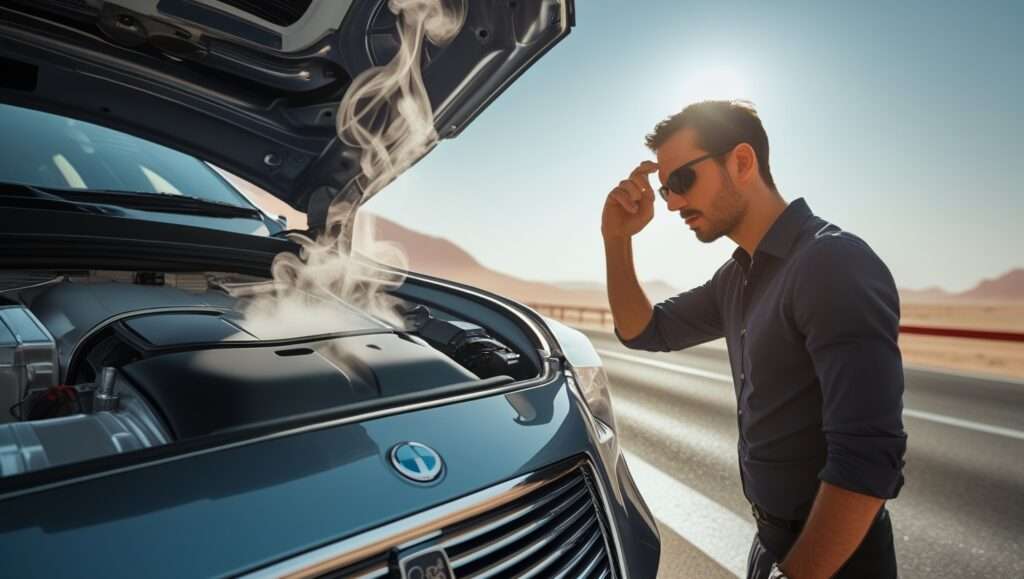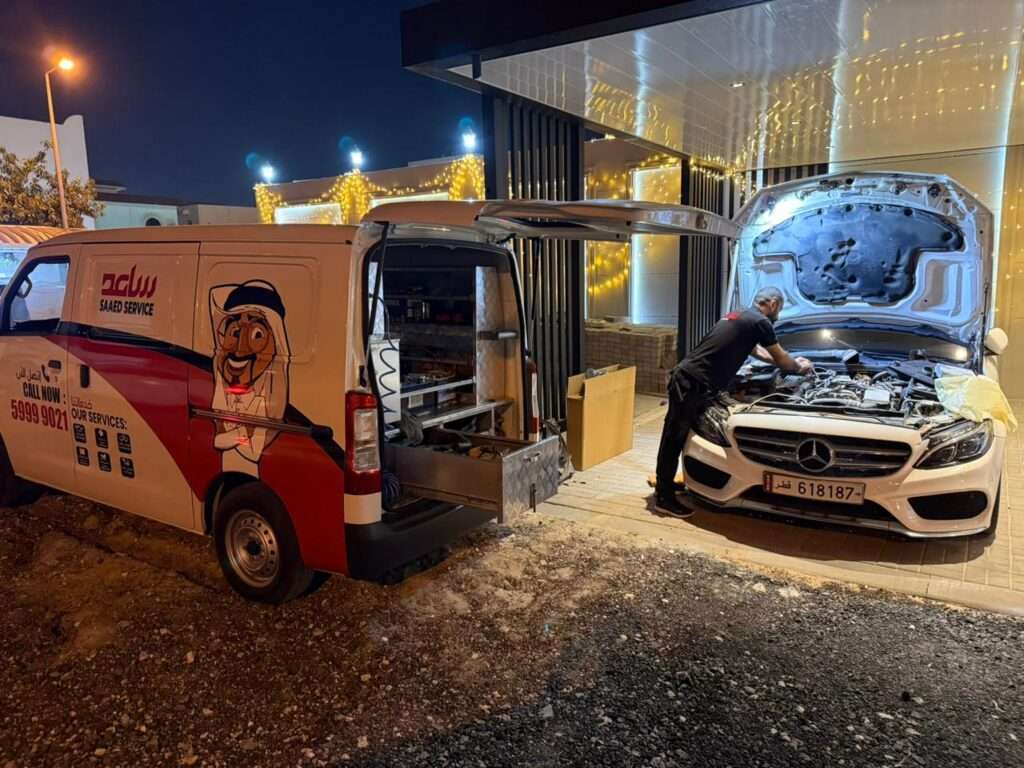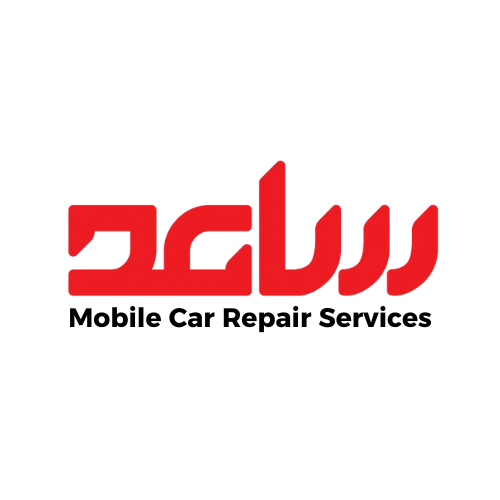Car Engine Issues
How to Protect Your Car's Engine in Qatar's Extreme Summer Heat?
In Qatar, where summer temperatures regularly soar above 45°C (113°F), your vehicle faces challenges that standard maintenance schedules simply don’t address. According to local service data, engine-related breakdowns increase by nearly 40% during Qatar’s peak summer months, with many of these issues being entirely preventable. While most car manufacturers design vehicles to operate in a wide range of conditions, Qatar’s extreme heat demands special attention and professional engine maintenance to ensure your engine remains reliable and its lifespan isn’t dramatically shortened.
With proper preventative maintenance and understanding of how Qatar’s unique climate affects your vehicle, you can significantly extend your engine’s life and avoid costly repairs. This comprehensive guide will walk you through everything you need to know about protecting your car’s engine during Qatar’s punishing summer heat.

Understanding How Heat Affects Your Engine
Your car’s engine is designed to operate at a specific temperature range, typically between 90°C and 105°C (195°F to 220°F). Modern cooling systems work efficiently to maintain this optimal range under normal conditions. However, Qatar’s extreme ambient temperatures create several unique challenges that can push cooling systems beyond their design limits.
The Science of Engine Heat Stress
When ambient temperatures regularly exceed 40°C (104°F), your engine’s cooling system must work much harder to maintain proper operating temperatures. This creates a cascade of effects throughout the engine that can lead to premature wear and potential failure without proper professional diagnosis and maintenance.
- Coolant Efficiency Reduction: Coolant’s ability to transfer heat diminishes as ambient temperatures rise, making the entire cooling system less effective.
- Oil Viscosity Changes: Engine oil thins more quickly in extreme heat, reducing its protective capabilities and increasing metal-to-metal contact between engine components.
- Accelerated Component Expansion: Metal components expand more dramatically in extreme heat, potentially changing critical tolerances within the engine.
- Increased Vapor Pressure: Cooling systems experience higher pressure, putting additional stress on hoses, gaskets, and the radiator cap.
- Faster Fluid Evaporation: Essential fluids like coolant and brake fluid evaporate more quickly, potentially leaving systems underprotected.
Qatar’s combination of extreme heat and high humidity creates particularly challenging conditions. While dry heat allows for more efficient radiator cooling through better airflow, Qatar’s humid conditions during certain months reduce cooling efficiency further, creating a “perfect storm” for engine stress.
Common Heat-Related Engine Problems in Qatar
Local mechanics report several recurring issues specific to Qatar’s climate:
- Premature Radiator Failures: The constant strain on cooling systems leads to radiator cracks and leaks far earlier than in temperate climates. These often require specialized repair techniques to address properly.
- Water Pump Deterioration: Seals and bearings in water pumps deteriorate faster due to constant high-temperature operation.
- Head Gasket Failures: The repeated expansion and contraction of engine components from extreme daytime heat to cooler nights can cause head gaskets to fail prematurely.
- Accelerated Oil Breakdown: Engine oil in Qatar can degrade up to 60% faster than in moderate climates, leading to reduced engine protection.
- Battery Fluid Evaporation: Extreme heat causes faster evaporation of battery fluid, leading to shortened battery life and unexpected failures.
Understanding these specific challenges is the first step toward implementing effective preventative measures to protect your vehicle.
Protect Your Car from Qatar’s Tough Conditions
Heat and dust make it even more important to take care of your car. Keep it running well by:
Getting regular check-ups
Fixing small issues before they get worse
Going to a trusted mechanic
What to Do Next
If your car is showing any of these warning signs, do not wait. Saaed Service’s mechanic can:
Find the problem before it gets worse
Prevent costly repairs
Keep your car running smoothly
Take care of your engine, and it will take care of you.
Warning Signs Your Engine is Heat-Stressed
Recognizing the early warning signs of heat-related engine stress can help you address issues before they lead to catastrophic failure. Be particularly vigilant for these indicators during Qatar’s summer months:
Dashboard Warning Lights
Never ignore these critical dashboard indicators during hot weather:
- Temperature Warning Light: This red or yellow indicator suggests your engine is operating beyond its safe temperature range. Pull over immediately if this light illuminates.
- Check Engine Light: While this can indicate numerous issues, during summer it often relates to heat-sensitive components like oxygen sensors or the catalytic converter.
- Battery Warning Light: This may indicate your charging system is struggling due to heat-related stress.
- Oil Pressure Warning: Low oil pressure in summer often indicates oil has thinned excessively due to heat.
Unusual Sensory Indicators
Your senses can detect early warning signs before dashboard lights appear:
- Sweet or Burning Smells: A sweet smell often indicates coolant leakage, while burning odors may suggest oil leaking onto hot engine components.
- Steam from Under the Hood: Any visible steam suggests coolant is escaping and vaporizing on hot engine parts.
- Unusual Engine Sounds: Knocking, ticking, or hissing noises that increase during hot weather may indicate heat-related issues.
- Fluid Puddles: Colorful fluid puddles beneath your parked car often indicate heat-stressed hoses or gaskets have failed.
Performance Changes
Heat stress typically manifests in noticeable performance changes:
- Reduced Power: An engine running hotter than designed will often deliver noticeably less power.
- Rough Idling: Heat can affect fuel vaporization and sensor function, causing unstable idle.
- Hard Starting: Particularly in the afternoon after your car has been parked in the sun, starting difficulties may indicate heat-related fuel system or battery issues.
- Unusual Transmission Behavior: Automatic transmissions may shift erratically when overheated.
If you notice any of these warning signs, it’s advisable to have your vehicle inspected by a professional before minor issues develop into major problems.
Preventative Maintenance Schedule for Qatar’s Summer
Standard maintenance schedules are designed for moderate climates and simply don’t account for Qatar’s extreme conditions. Here’s a Qatar-specific maintenance timeline to keep your engine protected:
Oil Change Frequency
In Qatar’s summer heat, conventional wisdom about oil change intervals needs adjustment:
- Conventional Oil: Change every 5,000 km or 2 months during summer (versus the standard 7,500-10,000 km recommendation).
- Synthetic Oil: Change every 7,500 km or 3 months during summer (versus the standard 10,000-15,000 km recommendation).
- Oil Grade Selection: Consider using oil with higher viscosity ratings during summer months (consult your owner’s manual for the upper range of recommended viscosity).
- Oil Filter Replacement: Always replace the oil filter with every oil change in Qatar, even if the manufacturer suggests less frequent replacement.
Cooling System Maintenance
Your cooling system requires special attention in Qatar’s climate:
- Coolant Flush and Replacement: Perform a complete system flush and coolant replacement annually, ideally before summer begins (versus the standard 2-3 year recommendation).
- Radiator Pressure Testing: Have your radiator and cooling system pressure-tested twice yearly to identify potential failure points before leaks develop.
- Thermostat Inspection: Have your thermostat checked annually, as these fail more frequently in extreme heat.
- Water Pump Inspection: Have the water pump inspected for leaks and bearing wear annually, rather than waiting for symptoms to appear.
- Cooling Fan Operation: Ensure electric cooling fans are operating properly before summer begins, as their failure can cause rapid overheating.
Belt and Hose Maintenance
Rubber components deteriorate much faster in Qatar’s heat and should be inspected more frequently:
- Visual Inspection: Check all belts and hoses monthly during summer for cracks, bulges, or brittleness.
- Belt Tension: Have belt tension checked quarterly, as heat can cause belts to stretch and lose effectiveness.
- Preventative Replacement: Replace hoses every 2 years regardless of appearance, as internal deterioration may not be visible.
- Clamp Inspection: Ensure all hose clamps are tight and free from corrosion quarterly.
This accelerated maintenance schedule may seem excessive compared to manufacturer recommendations, but it’s calibrated to Qatar’s specific climate challenges and can save thousands in repair costs.

Professional vs. DIY Maintenance
While some maintenance tasks can be performed at home, others require professional expertise, especially in extreme climates like Qatar’s.
DIY-Appropriate Tasks
These maintenance items can be handled by most car owners with basic tools:
- Regular Fluid Level Checks: Check oil, coolant, power steering, and brake fluid levels weekly during summer months.
- Radiator External Cleaning: Keep the radiator and AC condenser free from debris and insects that can reduce cooling efficiency.
- Battery Terminal Cleaning: Clean battery terminals monthly to ensure good electrical connections.
- Belt and Hose Visual Inspection: Perform visual checks for obvious cracks or wear.
- Air Filter Replacement: Replace air filters more frequently in Qatar due to dust conditions.
Professional Maintenance Tasks
These items should be left to qualified technicians:
- Cooling System Pressure Testing: Requires specialized equipment to safely test the system under pressure.
- Coolant Flush and Replacement: Proper disposal of old coolant and system bleeding requires professional tools.
- Thermostat Replacement: Often requires significant disassembly and proper system bleeding afterward.
- Diagnostic Scanning: Modern engine management systems require professional diagnostic equipment to identify heat-related issues.
- Water Pump Replacement: A complex job requiring specialized tools and expertise.
The Mobile Service Advantage
For busy residents of Qatar, mobile maintenance services offer significant advantages:
- Reduced Vehicle Heat Exposure: Your car doesn’t sit idling in traffic on the way to a garage, adding heat stress.
- Convenience: Maintenance can be performed at your home or workplace, eliminating the need to rearrange your schedule.
- Personalized Service: Technicians can focus entirely on your vehicle rather than juggling multiple jobs.
- Regular Scheduling: The convenience makes it more likely you’ll stick to the accelerated maintenance schedule Qatar’s climate demands.
Mobile services are particularly valuable for preventative maintenance, allowing you to maintain your vehicle properly without the hassle of garage visits.
Product Recommendations for Engine Heat Protection
Selecting the right products for Qatar’s climate can significantly enhance your engine’s heat resistance:
Engine Oils for Extreme Heat
Not all engine oils perform equally in extreme temperatures:
- Mobil 1 Extended Performance: Offers excellent high-temperature stability and is widely available in Qatar.
- Castrol EDGE Supercar: Formulated for high-performance engines operating in extreme conditions.
- Royal Purple High Performance: Contains additives specifically designed to maintain viscosity in high heat.
- Total Quartz 9000 Future XT: Provides excellent thermal stability in Gulf climate conditions.
When selecting oil, always stay within your manufacturer’s recommended viscosity range, but opt for the higher end of that range during summer months.
Coolants for Qatar’s Climate
Coolant selection is critical for Qatar’s extreme temperatures:
- Zerex G-05: Offers excellent high-temperature protection and is compatible with most vehicles.
- Valvoline Zerex Asian Vehicle: Specifically formulated for Japanese and Korean vehicles common in Qatar.
- Prestone Command Heavy Duty: Designed for extreme conditions and offers extended protection.
- Liqui Moly Radiator Antifreeze: Popular among European vehicle owners in Qatar for its high-temperature stability.
Always use premixed coolant or mix with distilled water rather than tap water, as Qatar’s tap water contains minerals that can cause cooling system deposits.
Additives and Treatments
Some additives can provide additional protection in extreme heat:
- Cooling System Water Wetter: Reduces coolant surface tension to improve heat transfer efficiency.
- Engine Oil Stabilizers: Can help maintain oil viscosity in extreme heat, though they should be used cautiously and according to manufacturer specifications.
- Fuel System Cleaners: Help maintain fuel injector and intake valve cleanliness, which can affect engine operating temperatures.
- Radiator Flush Products: Use before coolant changes to remove scale and deposits that reduce cooling efficiency.
While additives can help, they’re not substitutes for regular maintenance and high-quality base fluids.
Conclusion
Qatar’s extreme summer heat creates unique challenges for vehicle engines that standard maintenance schedules don’t adequately address. By understanding how heat affects your engine, recognizing early warning signs, following a Qatar-specific maintenance schedule, knowing when to seek professional help, and using the right products, you can significantly extend your engine’s life despite the harsh climate.
The investment in proper preventative maintenance is substantially less than the cost of major engine repairs or replacement. For example, regular oil changes and cooling system maintenance might cost QAR 1,500-2,000 annually, while engine repairs due to heat-related damage can easily exceed QAR 10,000-15,000.
Don’t wait for warning signs to appear—be proactive about your vehicle’s health in Qatar’s challenging climate. Schedule a comprehensive engine check-up before the peak summer heat arrives to ensure your cooling system is ready for the challenge ahead.
Frequently Asked Questions
Q: How much more frequently should I change my oil in Qatar compared to manufacturer recommendations?
A: As a general rule, reduce the manufacturer’s recommended interval by 30-40% during summer months. If the recommendation is 10,000 km, change your oil every 6,000-7,000 km instead. In Qatar’s extreme heat, oil breaks down faster and loses its protective properties more quickly than in moderate climates.
Q: Can I use water instead of coolant in an emergency?
A: While distilled water can be used temporarily in an absolute emergency, replace it with proper coolant as soon as possible. Water alone boils at a lower temperature and lacks the corrosion inhibitors and lubricating properties of coolant. In Qatar’s heat, using water alone could lead to overheating and significant engine damage.
Q: Why does my car overheat only when idling in traffic?
A: At idle, your car relies entirely on the electric cooling fan rather than airflow from movement. In Qatar’s heat, this puts maximum stress on the cooling system. Have your cooling fan, thermostat, and water pump checked by a professional. These components are particularly stressed during Qatar’s summer traffic congestion.
Q: Is it worth paying extra for synthetic oil in Qatar?
A: Absolutely. Synthetic oils maintain their protective properties much better in extreme heat and may extend your oil change interval slightly compared to conventional oils. The additional cost is justified by the superior protection they provide to your engine in Qatar’s challenging climate.
Q: How can I tell if my coolant needs changing if it still looks good?
A: Coolant should be tested, not just visually inspected. Professionals use test strips to check the pH and protective additive levels, which deteriorate even when the coolant still looks acceptable. In Qatar, coolant can maintain its color but lose its protective properties due to extreme heat exposure.
Q: What’s the best time of day to check my engine oil level in Qatar’s summer?
A: Check your oil in the early morning before starting your car, when the engine is cool and the oil has settled in the pan. This gives the most accurate reading. If checking after driving, wait at least 10-15 minutes for the oil to drain back to the pan.
Q: How do Qatar’s dust conditions affect my engine?
A: Qatar’s fine dust can clog air filters quickly, restricting airflow and causing the engine to run hotter. It can also contaminate oil more rapidly. Professional engine servicing should include thorough inspection of all air intake components and more frequent air filter replacements than in less dusty environments.
Q: Should I use a higher octane fuel during summer in Qatar?
A: If your vehicle manufacturer recommends premium fuel, definitely use it during summer. For vehicles designed to run on regular fuel, higher octane generally won’t provide significant benefits for cooling. Focus instead on proper maintenance of your cooling system.
Q: How effective are aftermarket engine cooling products like “radiator boosters” in Qatar’s climate?
A: Most aftermarket “quick fix” cooling products provide minimal benefits compared to proper maintenance. Instead of investing in these products, put that money toward professional cooling system maintenance and high-quality coolant. A properly maintained stock cooling system will outperform a neglected system with aftermarket additives.
Q: My temperature gauge reads normal, but my car is using more coolant than usual. Should I be concerned?
A: Yes, this is a serious warning sign that should not be ignored. Coolant consumption without visible leaks often indicates internal leakage, possibly into the combustion chambers through a failing head gasket. This requires immediate professional diagnosis before catastrophic engine damage occurs.
